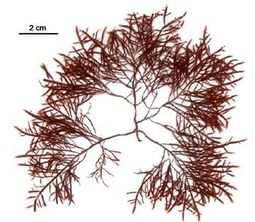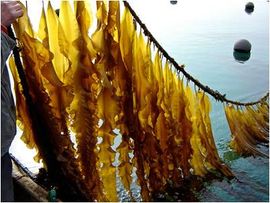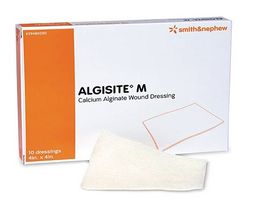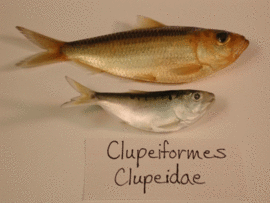Difference between revisions of "Marine derived E-numbers"
Nelle Meyers (talk | contribs) |
Nelle Meyers (talk | contribs) |
||
| Line 6: | Line 6: | ||
E 406, more commonly known as agar, is derived from algae of the genera Gelidium, Pterocladia and Gracilaria. Agar consists of different polysaccharides that have their backbone structure in common. These polysaccharides contain D – and L- galactose, this gives them the ability to form gels and viscous solutions under the right conditions. E406 has a wide range of applications. It is used as an emulsifier, stabilizer, gelling agent, and thickener. It is used for preparing different kinds of food, for example fast food (burgers), ice cream and tinned food. Gelidium (fig. 1) is a genus of red algae which can be found all over the world except in Antarctica. Pterocladia (fig 2.) and Gracilaria are also two genera consisting of red algae that contain the required Polysaccharides. The largest agar-producing continents are America and the Asia-Pacific region [3]. The polysaccharides used for the production of agar are found inside the cell wall of the algae [4]. | E 406, more commonly known as agar, is derived from algae of the genera Gelidium, Pterocladia and Gracilaria. Agar consists of different polysaccharides that have their backbone structure in common. These polysaccharides contain D – and L- galactose, this gives them the ability to form gels and viscous solutions under the right conditions. E406 has a wide range of applications. It is used as an emulsifier, stabilizer, gelling agent, and thickener. It is used for preparing different kinds of food, for example fast food (burgers), ice cream and tinned food. Gelidium (fig. 1) is a genus of red algae which can be found all over the world except in Antarctica. Pterocladia (fig 2.) and Gracilaria are also two genera consisting of red algae that contain the required Polysaccharides. The largest agar-producing continents are America and the Asia-Pacific region [3]. The polysaccharides used for the production of agar are found inside the cell wall of the algae [4]. | ||
| − | + | ||
| − | + | ||
| − | + | ||
| − | + | ||
| + | [[File:gelidium.jpg|Gelidium|270px]] | ||
| + | [[File:pterocladia.jpg|Pterocladia|255px]] <br style="clear:both;"/> | ||
| + | Fig 1, 2. Gelidium (left) and Pterocladia (right), two red algae which contain the required polysaccharides for the preparation of agar.<ref name="ciencias">ciencias.udc.es</ref><ref name="marevita">http://marevita.org/index.php?option=classification&path=algues et plantes html</ref> | ||
| Line 15: | Line 18: | ||
Alginates are cell wall constituents found in brown algae or Phaeophyceae. Most species of brown algae contain alginate but a profitable extraction is only possible ofthe larger kelps. Over four million tons of Saccharina japonica (fig 3) are grown by mariculture in China (data from 2009) [5]. Other mentionable manufacturers are California, Norway, Scotland and Japan [5]. Alginate is widely used in ice cream, milkshakes, instant desserts, custard tarts and as suspending agents in soft drinks, this is only the start of a long list. Apart from the food industry alginates are also used in the textile industry and for the production of alginate bandages. These bandages also known as alginate dressings can be flat, freeze dried porous sheets or can occur as flexible fiber dressings. They are most of all used for moist cavity wounds (fig 4.). The base constituents of the bandages include calcium alginate, this helps to form a soft gel once in contact with the wound exudate [6]. The calcium ions aid the blood clotting, furthermore the bandage has a high absorbency of fluid and the ability to maintain a moist wound environment [6]. In the textile industry sodium alginates are mixed with carboxymethylated polysaccharides and used as a thickening agent when printing with reactive dyes [7]. | Alginates are cell wall constituents found in brown algae or Phaeophyceae. Most species of brown algae contain alginate but a profitable extraction is only possible ofthe larger kelps. Over four million tons of Saccharina japonica (fig 3) are grown by mariculture in China (data from 2009) [5]. Other mentionable manufacturers are California, Norway, Scotland and Japan [5]. Alginate is widely used in ice cream, milkshakes, instant desserts, custard tarts and as suspending agents in soft drinks, this is only the start of a long list. Apart from the food industry alginates are also used in the textile industry and for the production of alginate bandages. These bandages also known as alginate dressings can be flat, freeze dried porous sheets or can occur as flexible fiber dressings. They are most of all used for moist cavity wounds (fig 4.). The base constituents of the bandages include calcium alginate, this helps to form a soft gel once in contact with the wound exudate [6]. The calcium ions aid the blood clotting, furthermore the bandage has a high absorbency of fluid and the ability to maintain a moist wound environment [6]. In the textile industry sodium alginates are mixed with carboxymethylated polysaccharides and used as a thickening agent when printing with reactive dyes [7]. | ||
| − | + | ||
| − | + | [[File:sjaponica.jpg|Saccharina japonica|270px]] | |
| − | + | [[File:algbandage.jpg|alginate bandages|255px]] <br style="clear:both;"/> | |
| − | + | Fig 3, 4. Saccharina japonica, a brown algae used for extraction of alginate (left); alginate bandages, mostly used for cavity wounds (right).<ref name="sacch">ref name="seaw">http://www.seaweed.ie/aquaculture/kelp_china.php</ref><ref name="band">http://www.pillbox123.com/shop/wound-care/alginate/</ref> | |
| + | |||
Carrageenan is a general name for polysaccharides found in some algae, they are build up from D-galactopyranose units only, in contrast to agar. It is widely used as an emulator. Carrageenan also reacts with milk proteins, it ensures that the milk constituents don’t fractionate. When you drink chocolate milk, it’s almost certain you’re consuming algae. These polysaccharides help to keep the chocolate in suspension [8]. Three kinds of Carrageenan are commercially interesting: Iota, Kappa and Lambda. Iota is a clear gel with no bleeding of liquid, Kappa is a brittle, strong rigid gel formed with potassium salts and Lambda has no gel formation, it forms high viscosity solutions [3]. The composition of these three kinds of Carrageenan can vary between the different kinds of algae [3]. | Carrageenan is a general name for polysaccharides found in some algae, they are build up from D-galactopyranose units only, in contrast to agar. It is widely used as an emulator. Carrageenan also reacts with milk proteins, it ensures that the milk constituents don’t fractionate. When you drink chocolate milk, it’s almost certain you’re consuming algae. These polysaccharides help to keep the chocolate in suspension [8]. Three kinds of Carrageenan are commercially interesting: Iota, Kappa and Lambda. Iota is a clear gel with no bleeding of liquid, Kappa is a brittle, strong rigid gel formed with potassium salts and Lambda has no gel formation, it forms high viscosity solutions [3]. The composition of these three kinds of Carrageenan can vary between the different kinds of algae [3]. | ||
| Line 48: | Line 52: | ||
| − | + | [[File:clupeidae.gif|Clupeidae|270px]]<br style="clear:both;"/> | |
| − | + | Fig 5.''Clupeidae''.<ref name="clup">http://apps.acesag.auburn.edu/mediamax/pictures/51/clupeiformes-clupeidae.html</ref> | |
| − | |||
| − | |||
| + | |||
The previous examples show that the demand for marine E-numbers is real and big business. Marine biotechnology supports the yield improvement of this industry and tries to keep it sustainable. | The previous examples show that the demand for marine E-numbers is real and big business. Marine biotechnology supports the yield improvement of this industry and tries to keep it sustainable. | ||
Revision as of 09:49, 30 July 2015
Marine derived E-numbers
E-numbers are code names for different kinds of substances that are used as food additives. The code consists of two parts, the letter E followed by a number. The E stands for ‘Europe’, the number is the identifier of a specific substance. The E named food additives are licensed for use within the European Union and Switzerland. Each E-number is a clearly defined substance that has to meet strict criteria, which help to protect the costumer [1]. E-numbers are derived from different sources. A well-known example of a terrestrial source is E 901, more commonly known as bees wax. Another important share of E-numbers is originating from marine ecosystems, including numerous food additives. Increasing research in the field of marine biotechnology ensures the development and discovery of new interesting substances that could be potential E-numbers. Some examples of existing marine E-numbers picked from the full list of E-numbers [2] are listed below.
E 406, more commonly known as agar, is derived from algae of the genera Gelidium, Pterocladia and Gracilaria. Agar consists of different polysaccharides that have their backbone structure in common. These polysaccharides contain D – and L- galactose, this gives them the ability to form gels and viscous solutions under the right conditions. E406 has a wide range of applications. It is used as an emulsifier, stabilizer, gelling agent, and thickener. It is used for preparing different kinds of food, for example fast food (burgers), ice cream and tinned food. Gelidium (fig. 1) is a genus of red algae which can be found all over the world except in Antarctica. Pterocladia (fig 2.) and Gracilaria are also two genera consisting of red algae that contain the required Polysaccharides. The largest agar-producing continents are America and the Asia-Pacific region [3]. The polysaccharides used for the production of agar are found inside the cell wall of the algae [4].


Fig 1, 2. Gelidium (left) and Pterocladia (right), two red algae which contain the required polysaccharides for the preparation of agar.[1][2]
Other examples of Emulsifiers, gelling agents and stabilizers are E400-405 and E 407, respectively known as alginates and Carrageenan.
Alginates are cell wall constituents found in brown algae or Phaeophyceae. Most species of brown algae contain alginate but a profitable extraction is only possible ofthe larger kelps. Over four million tons of Saccharina japonica (fig 3) are grown by mariculture in China (data from 2009) [5]. Other mentionable manufacturers are California, Norway, Scotland and Japan [5]. Alginate is widely used in ice cream, milkshakes, instant desserts, custard tarts and as suspending agents in soft drinks, this is only the start of a long list. Apart from the food industry alginates are also used in the textile industry and for the production of alginate bandages. These bandages also known as alginate dressings can be flat, freeze dried porous sheets or can occur as flexible fiber dressings. They are most of all used for moist cavity wounds (fig 4.). The base constituents of the bandages include calcium alginate, this helps to form a soft gel once in contact with the wound exudate [6]. The calcium ions aid the blood clotting, furthermore the bandage has a high absorbency of fluid and the ability to maintain a moist wound environment [6]. In the textile industry sodium alginates are mixed with carboxymethylated polysaccharides and used as a thickening agent when printing with reactive dyes [7].


Fig 3, 4. Saccharina japonica, a brown algae used for extraction of alginate (left); alginate bandages, mostly used for cavity wounds (right).[3][4]
Carrageenan is a general name for polysaccharides found in some algae, they are build up from D-galactopyranose units only, in contrast to agar. It is widely used as an emulator. Carrageenan also reacts with milk proteins, it ensures that the milk constituents don’t fractionate. When you drink chocolate milk, it’s almost certain you’re consuming algae. These polysaccharides help to keep the chocolate in suspension [8]. Three kinds of Carrageenan are commercially interesting: Iota, Kappa and Lambda. Iota is a clear gel with no bleeding of liquid, Kappa is a brittle, strong rigid gel formed with potassium salts and Lambda has no gel formation, it forms high viscosity solutions [3]. The composition of these three kinds of Carrageenan can vary between the different kinds of algae [3].
| Algae | Composition |
|---|---|
| Chondrus crispus | mixture of kappa and lambda |
| Kappaphycus alvarezii | mainly kappa |
| Eucheuma denticulatum | mainly iota |
| Gigartina skottsbergii | mainly kappa, some lambda |
| Sarcothalia crispata | mixture of kappa and lambda |
Not only algae are a source of food additives, eight E-numbers (E626-633) can be obtained from sardines (Clupeidae) as well (fig. 5). Sardines are a source of flavour enhancers (E 627-628) and natural acids (E626, E629-633) [9]. These natural acids often occur in crisps or other potato snacks, gravy granules and pre-cooked rice [10].

Fig 5.Clupeidae.[5]
The previous examples show that the demand for marine E-numbers is real and big business. Marine biotechnology supports the yield improvement of this industry and tries to keep it sustainable.
References
- ↑ ciencias.udc.es
- ↑ http://marevita.org/index.php?option=classification&path=algues et plantes html
- ↑ ref name="seaw">http://www.seaweed.ie/aquaculture/kelp_china.php
- ↑ http://www.pillbox123.com/shop/wound-care/alginate/
- ↑ http://apps.acesag.auburn.edu/mediamax/pictures/51/clupeiformes-clupeidae.html